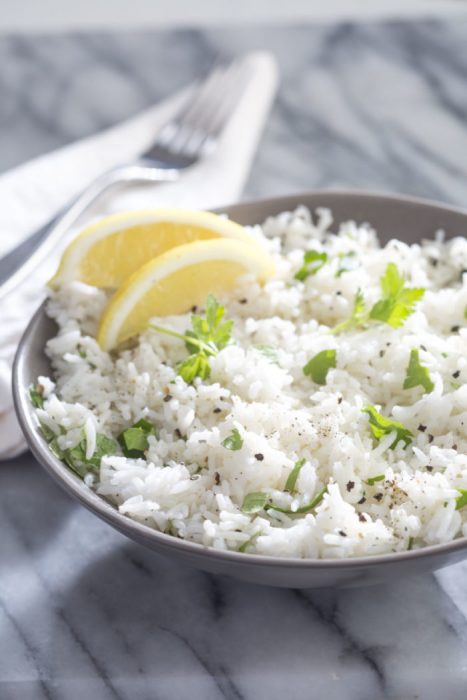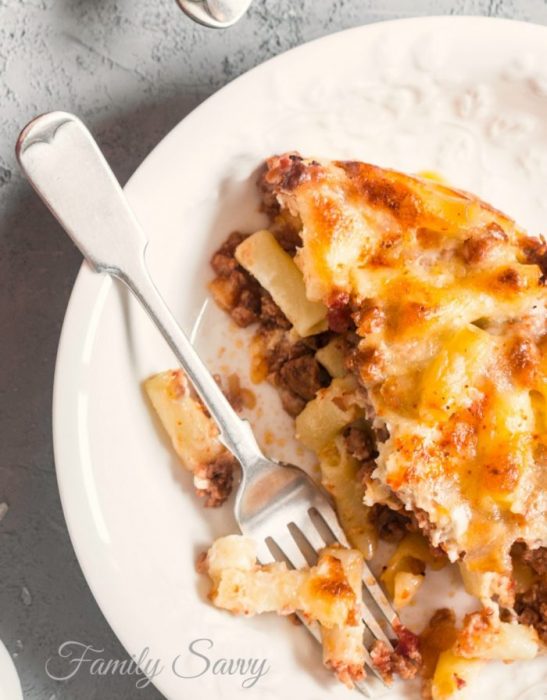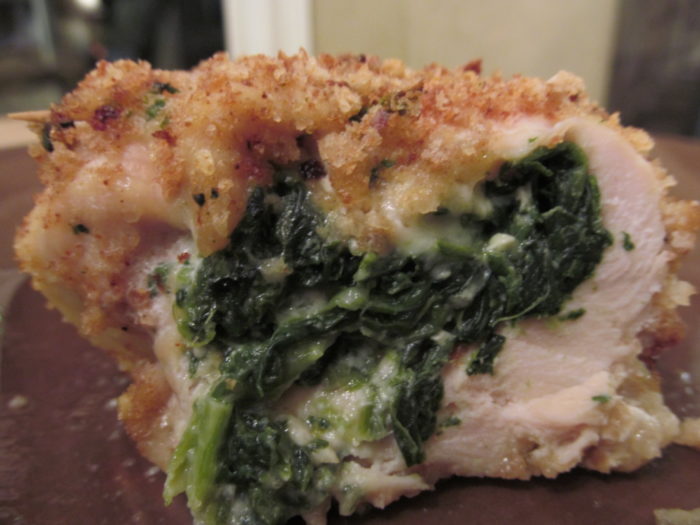The Best Taziki’s Basmati Rice You’ll Ever Make
This is the REAL RECIPE for the Taziki’s Basmati Rice, likely the most popular side ordered alongside the Greek grilled chicken, lamb, and shrimp.

Here in Birmingham, Taziki’s Mediterranean Cafe literally has a cult following. Most everyone I know eats at Taziki’s often, whether dine in or take out. The food is healthy, fresh, and always delicious.
Is Basmati rice the same as white rice?
No. Basmati rice has the longest grains of any rice and is also extremely narrow, with pointy ends. It is common in Indian and Mediterranean cooking.
Of all the sides served at Taziki’s Mediterranean Cafe, basmati rice is one of the most popular. It is soft, light, buttery, and perfectly seasoned with lemon and parsley. It pairs perfectly with any of Taziki’s dishes, but especially with the chicken, lamb, and shrimp.
Years ago, Taziki’s founder Keith Richards shared this family recipe on AL.com with the important caveat to “use fresh lemon, butter, and fresh parsley.” This really is what makes this rice so fresh and fabulous.
Does basmati rice need more water?
Yes, it calls for a higher water-to-rice ratio compared to other varieties such as jasmine or short-grain rice. This is particularly true when preparing brown basmati rice, where pre-soaking becomes essential to achieve well-hydrated and plump grains.
Is it better to soak basmati rice before cooking?
Delish suggests soaking them for a maximum of 30 minutes. This will initiate the water absorption process, reducing the cooking time required! By rinsing your rice before cooking, you’ll eliminate the thin layer of natural starch, preventing it from clumping together when cooked!
What to do if you forgot to soak basmati rice?
When using basmati rice, you can achieve excellent results without the need for soaking or pre-rinsing. Simply place the rice and salt in a pan with an ample amount of boiling water, cook until tender, then drain it using a colander. To remove any excess starch, pour a kettle full of boiling water over the drained rice. Voila! Your basmati rice is now ready, with no stickiness whatsoever.
What happens if you don’t wash basmati rice?
Failure to rinse the rice will result in the residual starch from the grains gelatinizing while cooking, leading to a sticky texture in the cooked rice. Instead of the desired fluffy grains typically served in restaurants, the rice will resemble more of a risotto-like consistency.
How many times should I wash basmati rice before cooking?
To eliminate starch from the surface of the grains and achieve fluffy rice, it is recommended to wash the rice multiple times (about 4 to 5) until the water runs clear. This process helps to remove the starch, which is responsible for making cooked rice sticky and gummy. By ensuring the removal of starch, you can enjoy rice with a lighter and more desirable texture.
Can I soak basmati rice in water overnight?
Recent research indicates that soaking rice overnight can significantly reduce arsenic levels by approximately 80 percent. This method not only helps lower the risk of heart diseases, diabetes, and cancer but also provides a healthier way to prepare rice for those who enjoy it. By adopting this practice, rice lovers can enhance the nutritional benefits of their meals.
Can I use chicken broth instead of water for rice?
Definitely! The choice of cooking liquid doesn’t impact the cooking process of rice, but it significantly influences the flavor profile. By using stock as the cooking liquid, the savory essence permeates the rice, resulting in a much more flavorful outcome compared to rice cooked in plain water. This simple adjustment enhances the overall taste and adds depth to the final dish.
Is basmati rice a good carb?
In addition to its other nutritional benefits, Basmati rice serves as a valuable source of complex carbohydrates. Complex carbohydrates are known for providing a sustained release of energy over time, effectively preventing significant spikes in blood sugar levels. By opting for Basmati rice as a part of your diet, you can reduce the likelihood of experiencing energy crashes and cravings commonly associated with the consumption of refined carbohydrates.
Should you stir basmati rice?
It’s best to stir the rice only once at the start of the cooking process. Excessive stirring can result in stickiness. If you’re cooking basmati rice on the stovetop, aim for a ratio of approximately 1 part rice to 2 parts water. This will provide the rice with a desirable consistency, neither overly dry and crunchy nor excessively wet and watery.
Why is my basmati rice soggy?
Consider reducing it to as little as 12 minutes, or alternatively, adjust the water ratio to 1.5 cups per cup of rice. If you find that the rice appears overly moist when you remove the lid, there’s no need to worry. Simply remove the lid and allow the rice to continue cooking for another minute or two to evaporate the excess water. This simple step can help achieve the desired texture and consistency.
Why is my basmati rice still hard?
If you find that your rice appears dry or has a hard and crunchy texture even after all the liquid has been absorbed, it’s possible that you didn’t add enough liquid initially. To rectify this, you can add up to ½ cup of water to the rice and return it to a simmer with the lid on. Remember to be patient and allow the rice to cook further until it reaches the desired tenderness. This additional moisture will help soften the rice and ensure a more pleasing texture.
How do you not overcook basmati rice?
After covering the pot with a well-fitting lid, reduce the heat to a simmer and let the rice cook for 15 to 20 minutes. This allows for complete absorption of the water and ensures the rice becomes tender. If you find that the rice is still too firm after the initial cooking time, simply add a few more tablespoons of water and continue cooking for a few additional minutes until it reaches the desired texture.
Can I eat basmati rice daily?
Absolutely! It is perfectly safe to include basmati rice in your daily diet. There are no known health concerns associated with consuming basmati rice when compared to other rice varieties. Enjoy it as part of your regular meals without worry!
Where does basmati rice come from?
Basmati rice is grown domestically in numerous countries, but its origins can be traced back to India and Pakistan, where it was initially cultivated. Among the two, India holds the majority share, contributing around two-thirds of the global supply. This strong connection to its Indian and Pakistani roots establishes basmati rice as an integral accompaniment to your beloved curry dishes.
What is so special about basmati rice?
One of the distinctive features of Basmati rice is its remarkable expansion during cooking, where it grows to more than twice its original length when dry. Unlike other rice varieties, Basmati grains expand exclusively lengthwise, enabling them to maintain their characteristic elongated and slender shape even after being cooked.
What makes basmati rice better?
Basmati rice is free of gluten and has minimal fat content. Not only does it provide all eight essential amino acids and folic acid, but it also has low sodium levels and zero cholesterol. With its low to medium glycemic index, Basmati rice ensures a gradual release of energy, resulting in sustained and balanced energy levels.
What does basmati rice taste like?
Derived from the Hindi word meaning “fragrant,” Basmati rice lives up to its name. It is renowned for its exceptional flavor and aroma, characterized by intense spiciness, nuttiness, and floral notes. It stands apart from other types of rice, offering a sensory experience that is distinct and captivating—though it’s important to note that this comparison is not in reference to hot sauce, cashews, or actual flowers.
Can you overcook basmati rice?
If you find that your rice is slightly sticky, there’s still a chance to save it. Transfer the rice to a colander and rinse it under cool water, gently separating the grains with your fingers. However, if the rice is excessively mushy, the optimal solution is to start afresh by making a new batch. You can repurpose the overcooked, leftover rice for other uses instead.
What does fresh parsley add to the flavor of rice?
Parsley is a bitter herb. (Our taste buds can sense sweet, sour, salty, bitter, and umami.) In addition to its great flavor, it aids digestion and makes almost any savory dish taste better.
What does fresh lemon juice add to the flavor of rice?
Fresh lemon juice appeals to the sour sense of taste, and it adds a fresh citrus zing to the palate as well.
What is basmati rice best for?
Basmati rice is a popular choice in Indian, Middle Eastern, and Persian cuisine. It serves as a versatile ingredient, commonly used as a side dish alongside soups, stews, vegetable dishes, and proteins. Additionally, it serves as the foundation for layered rice delicacies like biryani and pilau, enhancing their flavors and textures.
How long does basmati rice last?
When stored correctly, shielded from infestation and drastic temperature changes, various types of uncooked rice such as regular white, whole grain brown, parboiled, jasmine, basmati, and instant rice can be preserved for extended durations. However, it is advisable to consume them before the “Best By” date, which is typically two years (730 days) from the manufacturing date, ensuring optimal quality.
How do you fluff up basmati?
The secret to achieving fluffy and light rice lies in steaming it. It is important to allow the rice to cook undisturbed, ensuring the grains remain intact and don’t break apart. After cooking, let the rice sit for five minutes without interference. Additionally, ensure the rice is adequately dried after cooking. Keep the rice covered from the moment it finishes cooking until it is ready to be served.
Can you add rice vinegar to basmati rice?
To prevent the rice starches from sticking together, a useful tip is to add a tablespoon of vinegar to the water when boiling basmati rice. This technique ensures that the cooked rice turns out fluffy and easily separable, without any clumping or sticking.
Can you refrigerate basmati rice?
For optimal preservation of cooked basmati rice, it is recommended to refrigerate it in sealed airtight containers or resealable plastic bags. When stored properly, cooked basmati rice can maintain its quality for a period of 4 to 6 days in the refrigerator.
Which type of basmati is best?
Daawat is renowned as one of India’s top brands for basmati rice. It is crafted using the finest-grade basmati rice, which is easily available to consumers. The Punjab province of India is where the premium quality basmati rice, known as Daawat Rozana Gold, is cultivated.
Is there any sugar in basmati rice?
In a 100 g serving, brown basmati rice contains 0 grams of sugar, while white basmati rice contains approximately 0.51 g of sugar. If you have concerns about whether basmati rice is suitable for individuals with diabetes, the answer is yes.
What rice is similar to basmati?
When it comes to long-grain substitutes for basmati rice, several options can be considered. Standard long-grain rice, jeerasar rice, white jasmine rice, Jeeraksala rice, brown basmati rice, Carolina Gold, and Texmati are suitable alternatives for dishes like biryani, pulao, and various Indian recipes. For a medium-grain alternative to white basmati rice, Sona Masoori is a good option to consider.
Why add butter to rice?
This is fairly obvious, but fresh, real cream butter imparts a rich flavor and also creates a magical trilogy with parsley and lemon juice.

This rice really is delicious, and it tastes exactly like Taziki’s version~because it is!!! How nice to be able to have an exact recipe from a favorite restaurant.
If you love rice, you might also want to try my French Onion Brown Rice Made in a Rice Cooker. It is like “church lady rice” but much healthier!
Note: This rice can be made in a rice cooker. Simply follow directions for making white or basmati rice, then add the specified ingredients to the rice once it is cooked.
If you make this, please let me know how it turns out! I try to reply quickly to everyone who posts a comment.
And please visit our Family Savvy storefront to see all my Amazon faves and must-haves for you, your home, and your loved ones.
Watch Me Make Taziki’s Basmati Rice:
As always, thanks so much for stopping by. Be blessed, and stay savvy!!!

Taziki's Mediterranean Cafe's Basmati Rice
This rice is one of the most popular sides at Taziki's Mediterranean Cafe.
Ingredients
- 2 cups basmati rice (long grain Indian Basmati rice)
- 3 cups water
- 4 ounces unsalted butter, melted
- 1 teaspoon salt
- 1 teaspoon pepper
- 1/2 cup (4 lemons) lemon juice
- 1/2 cup parsley, fresh chopped
Instructions
- Place water and rice in 8-quart pan with lid.
- Bring rice to rapid boil while covered.
- When water reaches boil, turn temperature to low.
- Cook for 12 to 15 minutes until rice is fluffy.
- Remove pan from burner and allow rice to sit for 2 to 5 minutes.
- Pour cooked rice into a medium mixing bowl.
- Add melted butter, salt, pepper, lemon juice & parsley.
- Stir until thoroughly cominbed.
Nutrition Information
Yield 8 Serving Size 1Amount Per Serving Calories 158Total Fat 12gSaturated Fat 7gTrans Fat 0gUnsaturated Fat 4gCholesterol 30mgSodium 276mgCarbohydrates 12gFiber 0gSugar 0gProtein 1g






Hi Mark, yes that is a fabulous combination, too!!!! Thanks for sharing this tip!!!
Instead of lemon/parsley you can also use lime/cilantro.
Hi! I love their shrimp and taziki sauce too, but I don’t have the recipes for them. I wish I did!!!!
This looks awesome! I love their rice so can’t wait to try this.
Is there a recipe for their shrimp and taziki sauce? Love those too but can’t seem to find any recipes for those.
Liz, I am so happy your family loves this recipe!!!! It tastes pretty close to the original Tazikis rice, which is outstanding.
Thank you for your kind words!!! Tell your family hello for me!!! XoXo
Jamie, I’ve never had the original version, but yours is divine. Your recipes are always a hit with my family! 5+ Stars! Liz
Staci, I am so glad you found the recipe and that you love it! It does taste exactly like Tazikis!!! Thank you for leaving a comment. Blessings to you!!! XoXo
This tastes exactly like the rice at Tzazikis!! Thank you so much for sharing! It’s a family favorite!